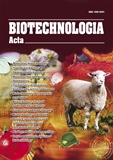ISSN 2410-7751 (Print)
ISSN 2410-776X (Online)

Biotechnologia Acta Т. 18, No. 2, 2025
P. 96-99, Bibliography 5 , Engl.
UDC 543.42:577.1:615.47
doi: https://doi.org/10.15407/biotech18.02.096
SYNTHESIS OF MONODISPERSE NANOSPHERES BY CITRATE REDUCTION OF AUCL3 FOR THEIR USAGE IN DNA HYBRIDIZATION BIOSENSORS
M.S. Sobolevskyi1, I.S. Kucherenko.1, A.M. Lopatynskyi 2, S.V. Dzyadevych 1, O.O. Soldatkin 1
1Institute of Molecular Biology and Genetics of the National Academy of Sciences of Ukraine, Kyiv;
2V.Ye. Lashkaryov Institute of Semiconductor Physics of the National Academy of Sciences of Ukraine, Kyiv
Aim. In this work, we described a simple and reliable method of synthesis of monodisperse spherical gold nanoparticles (AuNPs) for DNA labeling in hybridization biosensors based on surface plasmon resonance (SPR) spectrometry.
Materials and Methods. Several samples of colloid AuNPs were prepared by citrate reduction of gold (III) chloride and studied with dynamical light scattering to determine their distribution by diameter. The samples with the least variance of AuNP diameters (8-33 nm) were designated for labeling of DNA probes used to amplify the signal of the SPR-based hybridization DNA biosensor.
Results. The experiments showed the possibility of synthesis of precision AuNPs from gold (III) chloride through control of the duration of their boiling. An optimal variation of the method of synthesis of such AuNPs was proposed. AuNPs synthesized by the described method were instrumental in achieving a substantial specific increase in biosensor signal.
Conclusions. The proposed method can be used to produce precision citrate-capped AuNPs equitable for use in a wide range of biosensors.
Keywords: hybridization DNA biosensors, surface plasmon resonance, gold nanoparticles, Turkevich synthesis, AuCl3
© Palladin Institute of Biochemistry of the National Academy of Sciences of Ukraine, 2025
Reerenes
1. Karnwal, A., Kumar Sachan, R.S., Devgon, I. (2024). Gold Nanoparticles in Nanobiotechnology:
From Synthesis to Biosensing Applications. ACS Omega, 9(28), 29966–29982. Published 2024 Jul
5. https://doi.org/10.1021/acsomega.3c10352
2. Alkilany, A. M., Murphy, C. J. (2010). Toxicity and cellular uptake of gold nanoparticles: what we
have learned so far? J. Nanopart. Res., 12(7), 2313–2333. https://doi.org/10.1007/s11051-010-
9911-8
3. Sobolevskyi, M., Soldatkin, O., Lopatynskyi, A., Chegel, V., Samoylov, A., Matsishin, M.,
Dzyadevych, S., Soldatkin, A. (2023). Application of modified gold nanoparticles to improve
characteristics of DNA hybridization biosensor based on surface plasmon resonance spectrometry.
Applied Nanoscience, 12, 7521–7529. https://doi.org/10.1007/s13204-023-02930-2
4. Kimling, J., Maier, M., Okenve, B., Kotaidis, V., Ballot, H., Plech, A. (2006). Turkevich method
for gold nanoparticle synthesis revisited. J. Phys. Chem. B., 110(32), 15700–15707. https://doi.
org/10.1021/jp061667w
5. Dong, J., Carpinone, P. L., Pyrgiotakis, G., Demokritou, P., Moudgil, B. M. (2020). Synthesis
of Precision Gold Nanoparticles Using Turkevich Method. Kona, 37, 224–232. https://doi.
org/10.14356/kona.2020011

